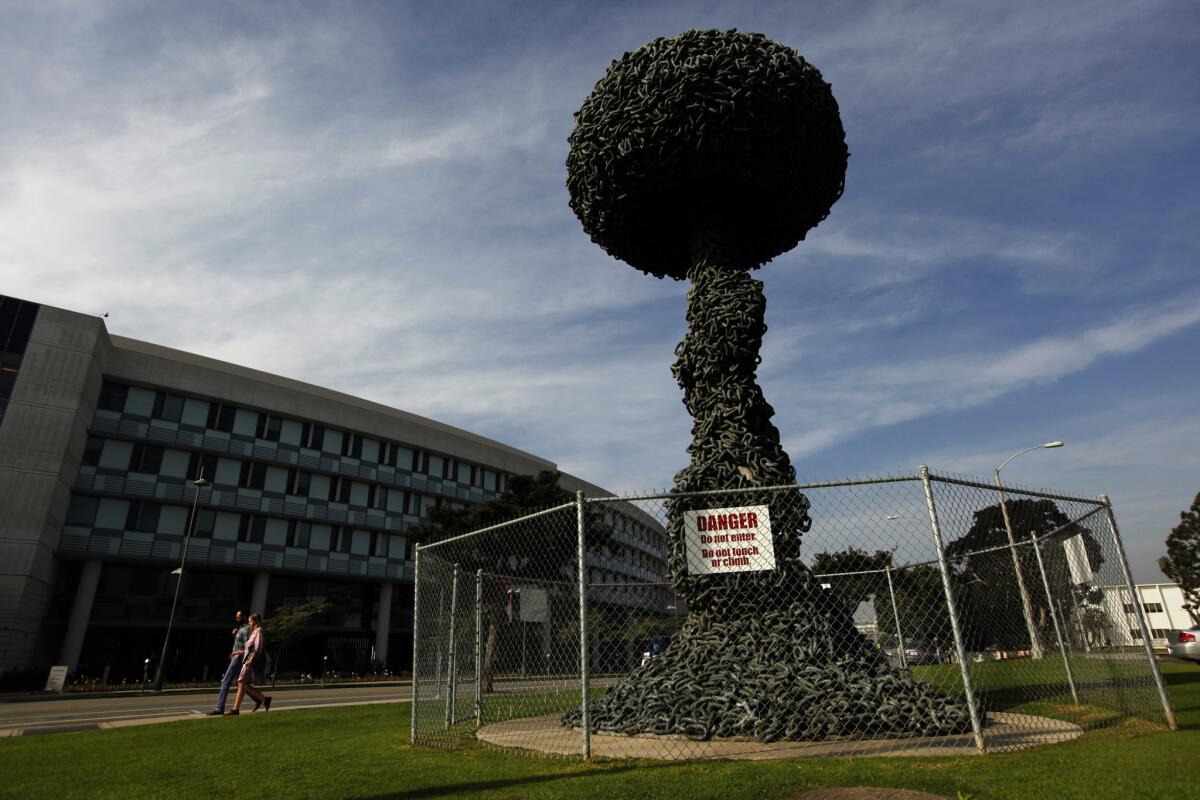Santa Monica Council votes to fund restoration of late cartoonist’s anti-nuclear war sculpture

The Santa Monica City Council has approved funds to help restore Paul Conrad’s “Chain Reaction” sculpture and surround it with landscaping.
- Share via
Pulitzer Prize-winning cartoonist Paul Conrad’s anti-nuclear war “Chain Reaction” sculpture in Santa Monica may have once and for all avoided a meltdown.
After years of uncertainty over the artwork’s fate, the Santa Monica City Council on Tuesday approved up to $275,000 in city funds to restore the sculpture and build a landscape barrier around it. The funding was unanimously approved as part of the council’s consent calendar.
The late Los Angeles Times cartoonist’s 5½-ton, 26-foot-tall creation is comprised of tangled chains — made of hollow copper tubing over fiberglass — in the shape of a mushroom cloud. It is inscribed with the words “This is a statement of peace. May it never become an epitaph” and has stood on Main Street between the courthouse and Santa Monica Civic Auditorium since 1991.
In 2011, city officials raised concerns about the artwork’s safety after seeing children climbing on it, saying the sculpture was not structurally sound. The City Council in March 2012, hampered by the loss of redevelopment money, approved the statue’s removal but allowed supporters several months to raise money to save it. That summer, Santa Monica’s Landmarks Commission designated the sculpture as a local landmark, complicating the removal plan.
Local peace activist Jerry Rubin, 71, co-founded a group called Save Chain Reaction and rallied support with the help of David Conrad, the son of the cartoonist. They raised more than $100,000 from hundreds of donors, also garnering the support of celebrity activists including TV producer Norman Lear and actors Tim Robbins and Ed Asner.
In 2014, the Santa Monica City Council agreed to accept the grass-roots funds and to provide general funds to complete the work of testing and stabilizing the sculpture.
The restoration plan approved Tuesday includes repairing chains and fiberglass areas removed during the testing of the structure, cleaning and recoating the chains and applying UV-resistant paint, according to a City Council report. The city will issue a request for bids from companies for the restoration project, which, according to city officials, was also vetted by Conrad’s family.
The plan includes the building of a drought-tolerant landscape barrier around the sculpture to prevent people from climbing on it, according to city documents.
‘Chain Reaction,’ for some time now, has been surrounded by a fence with a red-lettered sign that warns: “Danger. Do not enter. Do not touch or climb.”
The restoration plan notes that members of the community, including the artist’s son, have expressed interest in adding lighting around the sculpture, which would add an additional $25,000 for design and construction to the project, city documents state.
Rubin, of Save Chain Reaction, was present for the council’s vote on Tuesday and called it a victory for the community. In 2013, he turned his 70th birthday party into a fundraiser for the statue.
The sculpture’s message of peace, he said, “is going to be needed for many more years and possibly decades to come.”
This sculpture is controversial, it’s thought-provoking, and that’s very positive in the realm of public art because it encourages dialogue and discussion and debate.
— Jerry Rubin, co-founder of Save Chain Reaction
“This sculpture is controversial, it’s thought-provoking, and that’s very positive in the realm of public art because it encourages dialogue and discussion and debate,” he said. “I think it’ll be a place where people will be able to come and reflect on the responsibility that all of us have to make peace and a world that’s free of nuclear weapons.”
Conrad, who died at age 86 in 2010, was The Times’ editorial cartoonist for 29 years, during which he won three Pulitzer Prizes for his drawings.
Joan Kroc, the late San Diego philanthropist, nuclear disarmament proponent and widow of McDonald’s founder Ray Kroc, paid the original $250,000 for the sculpture. It was built according to Conrad’s designs by Peter Carlson, who also fabricated scores of large pieces for artists such as Robert Rauschenberg and Roy Lichtenstein.
“Chain Reaction” hasn’t been without criticism. The statue was placed in Santa Monica in 1991, several years after Conrad offered it to the city. A scale model was displayed at City Hall next to a ballot box, and visitors voted against it, 730 to 392, in 1989. The City Council finally agreed to accept it in 1990 after the Santa Monica Arts Commission voted multiple times to accept it.
Former Santa Monica City Councilman Dennis Zane, who voted against putting it in the city, told The Times in 1991, “I think Paul Conrad is brilliant, but the piece is ugly. That piece in that place is a non sequitur.”
Conrad had also offered the sculpture to the City of Beverly Hills, which rejected it because an appropriate site could not be found.
Twitter: @haileybranson | Google+
ALSO
Little Saigon probably won’t host Tet Festival in 2016
Man arrested in connection with deadly Metro bus stabbing in Highland Park
Veterans Day parades in Southern California honor ‘those willing to risk their lives’
More to Read
Sign up for Essential California
The most important California stories and recommendations in your inbox every morning.
You may occasionally receive promotional content from the Los Angeles Times.











